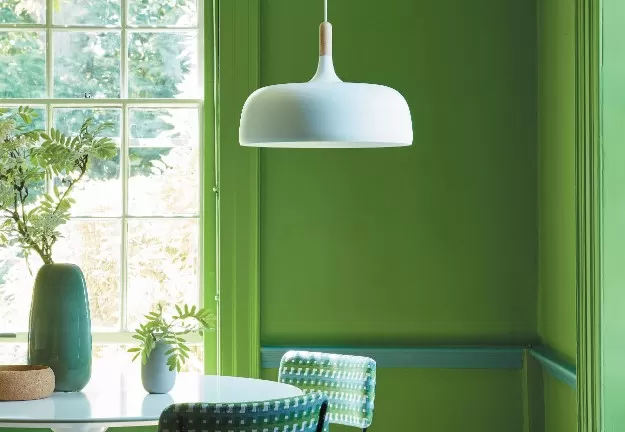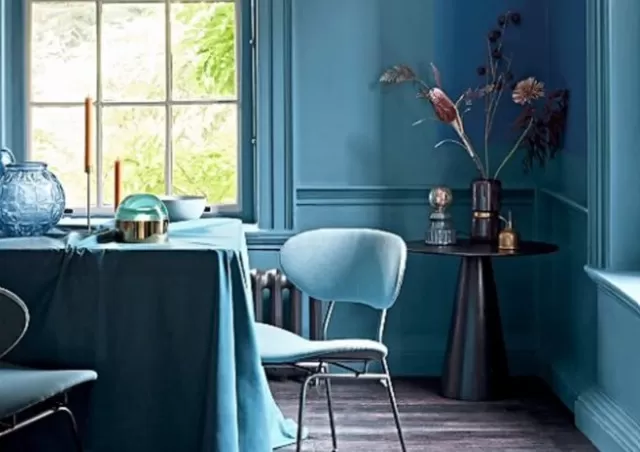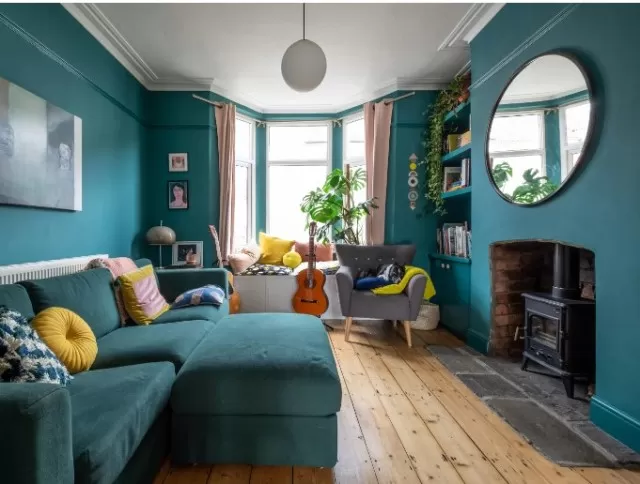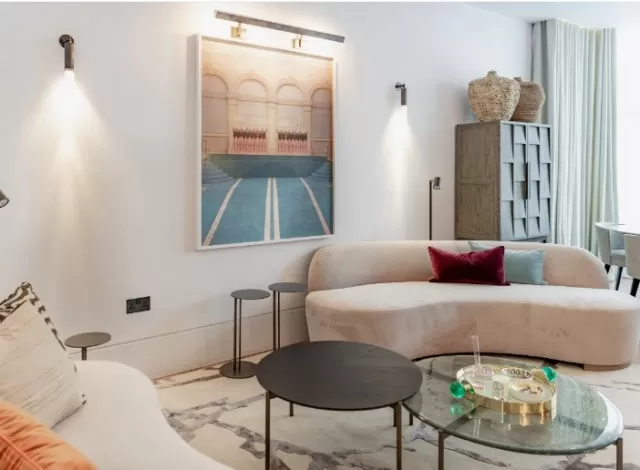Color Drenching: The Newest Essential Trend. Immerse Your Space with Color Drenching
Creamy whites and neutral tones step aside as color drenching takes center stage. This trend embraces bold saturation by painting every surface with a single hue, creating an immersive and visually stunning experience. From rich emerald greens to soft blues, the choice is yours to make a statement or add subtle depth. Let color drenching transform your space into a captivating masterpiece.
Elevate Your Space with Color Drenching: The Maximalist Appeal

As the desire for vibrant and energetic environments grows, color drenching emerges as a captivating trend in contemporary interior design.
In a departure from minimalism, people seek personality and stimulation in their homes. Color drenching offers an instant infusion of character and playfulness, satisfying the craving for vivid, immersive spaces.
This trend aligns with the rise of maximalist aesthetics, celebrating bold expressions through mural installations, striking wallpapers, and “clustercore.
” Interior designers recognize color drenching as a cost-effective alternative to achieve a similar impact. With its custom look and thoughtful execution, color drenching delivers a remarkable transformation, granting your space the allure of high-end design without breaking the bank.
How to Embrace the Color Drenching Trend in Your Home
Choose the Right Color: Select a hue that resonates with your personal style and complements your existing decor.
Whether it’s a vibrant, attention-grabbing shade or a more subdued tone, ensure it’s a color you love and can envision throughout your space.
Plan the Application: Decide which surfaces you want to paint with the chosen color.
Consider painting the walls, ceiling, baseboards, trim, and doors for a fully immersive experience. You can also opt for a more selective approach by focusing on specific areas or architectural features to create a focal point.
Test Swatches: Before committing to the entire color drenching process, test swatches of the chosen color on different walls or surfaces in your home.
Observe how the color interacts with light at different times of the day and in various parts of the room. This step will help you ensure the color works well in your space.
Prepare Properly: Proper preparation is essential for a successful color drenching project.
Clean and prime the surfaces to ensure smooth and even application. Use painter’s tape to protect areas you want to keep free of paint and cover furniture and flooring to prevent accidental spills or splatters.
Begin Painting: Start by painting the walls and work your way through the other surfaces.
Take your time and apply multiple coats if necessary to achieve the desired saturation and depth of color. Allow each coat to dry completely before proceeding to the next.
Consider Contrasting Elements: While color drenching involves saturating a space with a single color, you can introduce contrasting elements through furniture, artwork, and accessories.
These can add visual interest and break up the color scheme, creating a balanced and dynamic look.
Experiment with Finishes: Explore different finishes for your painted surfaces, such as matte, satin, or glossy.
Each finish can contribute to the overall aesthetic and impact the way light interacts with the color, adding further dimension to your space.
Remember, color drenching is about embracing a bold and immersive experience.
Have fun with the process and let your creativity guide you. With careful planning and execution, you can transform your home into a vibrant and personalized haven that reflects your unique style.
Embracing Color Drenching in Small Doses

If you’re hesitant to fully commit to color drenching, there are ways to experiment with the trend in smaller doses.
Here are a few approaches to consider:.
Start with a Small Room: Choose a smaller space, such as a powder room, a Home Office, or a Cozy Reading Nook, to begin your color drenching journey.
This allows you to get a feel for the impact of a saturated color without overwhelming a larger area.
Focus on Key Spots: Instead of painting the entire room, select a few key spots to incorporate your chosen bold hue.
This could include an accent wall, a built-in bookshelf, or a statement piece of furniture. By strategically placing bursts of color, you can create focal points that add visual interest and energy to the space.
Gradual Expansion: Start by painting the walls and ceiling in your chosen color.
Live with it for a while to see how it resonates with you. If you’re happy with the result, you can gradually incorporate the color into other elements of the room, such as furniture, drapery, or accessories.
This allows you to adjust the intensity of the color and find the right balance for your taste.
Coordinating Walls and Trim: For a cohesive look, consider painting both the walls and trim in the same hue.
This approach creates a seamless flow and can make the room feel more cohesive and unified. To introduce variety, incorporate accent colors through fabrics, rugs, and decor pieces.
Play with Accent Colors: If you prefer a more subtle approach, use color drenching as a backdrop and introduce accent colors through drapery, furniture, and accessories.
This allows you to add pops of color and create a dynamic interplay between the saturated walls and the accent elements.
Remember, color drenching is a bold statement, but you have the flexibility to tailor it to your comfort level.
By starting small and gradually expanding, you can explore the trend and find the right balance that suits your style and enhances your space.
Creating Depth with Different Shades of the Same Color

When exploring color drenching, there are various approaches you can take to achieve a captivating and harmonious look.
Consider the following suggestions:.
Consistent Color Scheme: For a cohesive and serene atmosphere, opt for using the same color throughout the space.
Extend the color to the walls, ceiling, trim, and even furniture. This creates a unified and immersive experience that can be surprisingly calming.
Layered Shades: Alternatively, you can incorporate different shades within the same color family.
This adds depth and visual interest to the room. For example, you could combine a cobalt blue sofa with walls in a softer baby blue shade, and introduce navy ottomans and draperies.
The layering of hues within the same color family creates a sophisticated and multidimensional effect.
The 60-30-10 Rule: To maintain balance and contrast when using multiple shades, follow the 60-30-10 rule.
Devote 60 percent of the room to the dominant color, which sets the overall tone. Allocate 30 percent to the secondary color, which complements the dominant color and adds variation.
Finally, use the remaining 10 percent for a contrasting accent color, which brings in a pop of excitement and prevents the space from feeling monotonous. Adhering to this rule helps create a well-balanced composition.
Gradual Introduction: If you’re new to color drenching or prefer a more gradual approach, start with a smaller percentage of the dominant color and gradually increase it over time.
This allows you to get comfortable with the boldness of the hues and make adjustments as needed.
Enhancing Depth with Paint Finishes

When embracing color drenching with a consistent color throughout the room, you can enhance the depth and visual interest by playing with different paint finishes.
Consider the following tips:.
Varying Finishes: Opt for different paint finishes on various surfaces to create contrast and add depth.
For instance, use a satin or semi-gloss finish for cabinets, doors, crown molding, and baseboards. These surfaces will reflect light differently and provide a subtle sheen that adds dimension to the space.
On the other hand, paint the walls in a flat finish to create a smooth, matte backdrop that allows the other elements to shine.
Reflective Properties: The use of glossier finishes on certain architectural features or surfaces will interact with light, creating interesting reflections and enhancing the room’s depth.
This interplay between light and texture can make the space more visually dynamic.
Cohesive Furniture and Décor: To amplify the monochromatic effect and reinforce the overall aesthetic, select furniture and décor pieces in the same tone or color family as your chosen paint.
These items will contribute to the overall depth by introducing natural textures, such as wood, woven materials, or fabrics, which add tactile interest and further enhance the richness of the space.
By experimenting with different paint finishes and incorporating complementary furniture and décor, you can create a visually captivating environment that fully embraces the color drenching trend and elevates the overall design of your room.
*The information is for reference only.